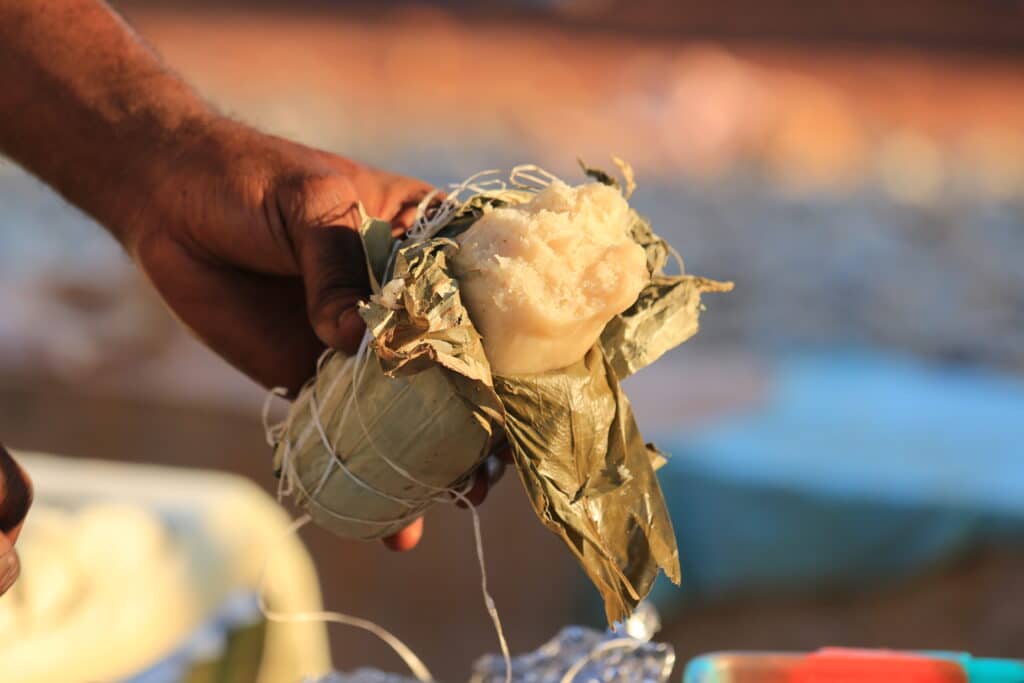At Remitly, we celebrate the rich diversity and traditions of our global customer base. As part of this celebration, we’re kicking off a series that explores traditional foods from around the world. Our next stop: the Democratic Republic of Congo, where we’ll introduce you to Kwanga, a delicious Congolese staple that has stood the test of time.
Meet Kwanga, A Congolese Staple
Kwanga, also known as chikwangue or chikwanga in some regions, is more than just a food item; it’s a cultural symbol deeply embedded in the Congolese way of life. Made from fermented cassava and often wrapped in banana leaves, this cassava bread is a go-to side dish commonly served with soups, meats, and vegetables. The fermented cassava gives Kwanga its distinct sour taste, much relished across Central Africa.
What Are the Two Congos?
When talking about Congo, it’s important to distinguish between the two countries: the Democratic Republic of Congo (DRC) and the Republic of Congo. Both nations have a shared history and culinary culture, including the widespread consumption of kwanga, but they are separate countries with their own distinct identities.
All About Cassava
Cassava is a root vegetable abundant in Africa, particularly in Central Africa, Angola, Cameroon, and Gabon. Rich in calcium and potassium, cassava roots are the primary ingredient for various African food staples like fufu, miondo, and bobolo. In addition to being a source of Vitamin C, cassava is processed into cassava flour and is sometimes referred to as “cassava stick” or “baton de manioc” in French-speaking regions.

Recipe for Congolese Kwanga
Ingredients
- Fermented cassava (see more below about where to find it)
- Banana leaves
Steps
- Start by kneading the fermented cassava into a dough-like consistency.
- Cut banana leaves into squares and blanch them in boiling water to make them pliable.
- Place a portion of the cassava dough onto a banana leaf and wrap it tightly.
- Boil or steam these wrapped packages for several hours until they are firm.
- Serve your kwanga with traditional dishes like okra soup or plantain stew.
Where to Buy Kwanga Ingredients in the U.S. or Europe
Grocery Stores:
- Ethnic Markets: African, Latin American, or Asian markets often stock fresh cassava roots and cassava products like cassava flour.
- Specialty Food Stores: Some health food stores or specialty grocery stores might carry cassava products.
- Mainstream Supermarkets: Chains like Walmart, Whole Foods, and Kroger may have a ‘World Foods’ or ‘Ethnic Foods’ section where you can find cassava or cassava flour. Some may even stock fresh cassava in the produce section.
Online:
- Amazon: A variety of cassava products are available, including cassava flour and sometimes even frozen cassava.
- Specialty Online Retailers: Websites that specialize in African, Latin American, or Asian foods may offer cassava products.
Local Farmers Markets:
Depending on your location, particularly if you’re in an area with a large African, Latin American, or Southeast Asian community, you may be able to find fresh cassava at a local farmers market.
Health Food Stores:
Stores like Whole Foods often stock gluten-free alternatives like cassava flour.
When shopping for cassava, keep in mind that it should be free of blemishes and firm to the touch. Cassava can be stored in a cool, dark place for a couple of weeks or can be frozen for longer storage.
Learn More about Congolese Cuisine
Interested in diving deeper into Congolese and Central African cuisine? From fufu to plantain and okra, the range of dishes is as diverse as the languages spoken in the region, including French and English. The inclusion of soups and stews full of local spices makes the cuisine truly unique.
Variations and Other Names for Kwanga
Kwanga goes by various names depending on the region and even the country. In Cameroon, it’s often called “bobolo,” and in Gabon, it may be referred to as “miondo.” Other variations include “chikwanga” in some Francophone African regions, and “baton de manioc” in others. In Angola and Ghana, you may find similar dishes, influenced by shared African culinary traditions.
So there you have it—our deep dive into Kwanga, a cornerstone of Congolese and African cuisine. We hope this adds a bit more flavor to your understanding of the rich, diverse culinary traditions that make up the tapestry of our global customer base.
Visit the homepage, download our app, or check out our Help Center to get started.